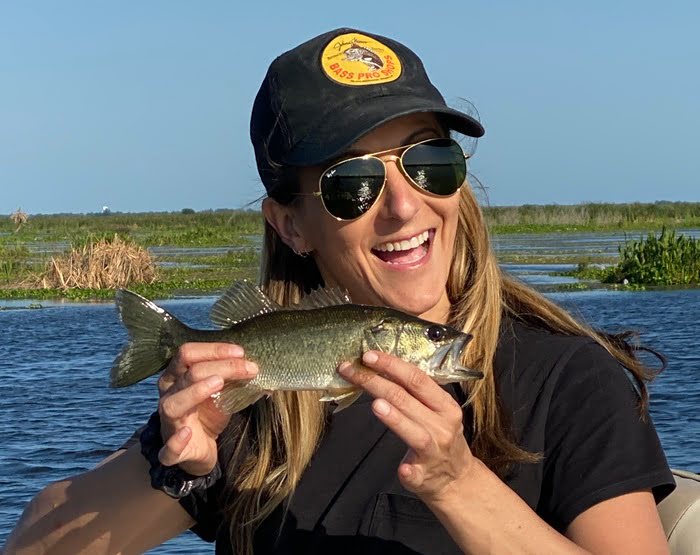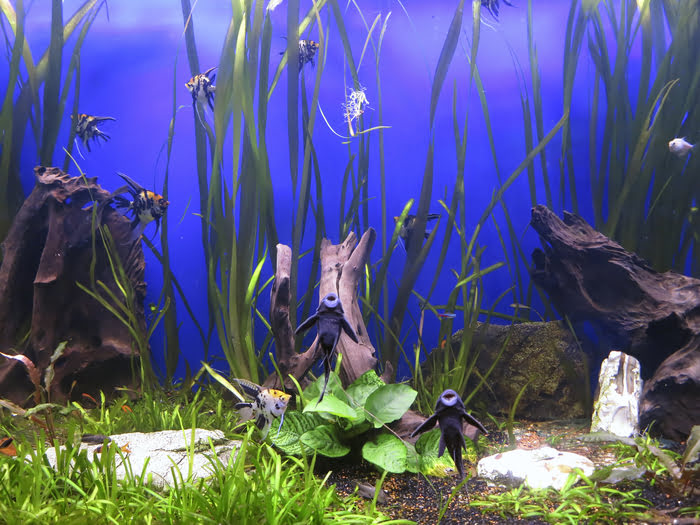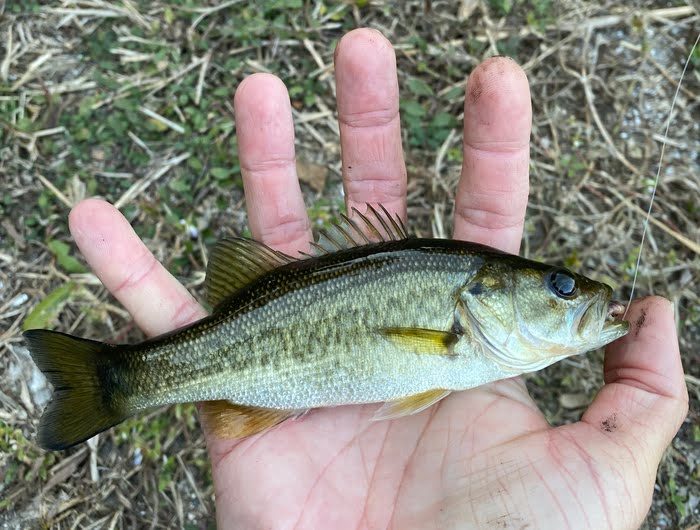“Can we keep a largemouth bass in our fish tank?”
This was the question I asked my dad as a 7-year old, and one I’m sure many young anglers have asked their parents as well.
I was sadly told “no,” but my old man conceded to letting me keep a small creek chub from my backyard, so I dropped it.
But the question still lingered… can you keep a largemouth bass as a pet?
The ins and outs of keeping largemouth bass can be a bit complicated, but this article aims to simplify the process so that you can chase the dream shared by all freshwater anglers at one time in your lives!
Table of Contents
Is it Legal?
First, lets address the main question most people ask when thinking of keeping a bass as a pet. It is legal? Well, the answer is it depends on your state and the fishing regulations in your area.
In short, if it is legal to possess and keep largemouth bass, than it is legal to keep one as a pet. But, the next issue becomes size…
For example, if your state or region does not allow you to keep bass below 16 inches in length, then technically, you could not keep a baby bass for your fish tank!
Fortunately, many states have regulations that allow anglers to keep or possess smaller largemouth bass.
For example, here in my home state of Florida, anglers can keep a total of 5 largemouth bass per day, only one of which may be 16 inches or longer in length.
This effectively means that there are no minimum length limits for largemouth bass in the state of Florida (unless specified on specific water bodies).
So, as long as you have a valid fishing license, and you caught it by legal means (no cast netting!), then you can keep a small largemouth bass for your aquarium.
Getting Your Bass: Start Small!
Even if you’re planning on keeping a giant, it is still considered wise to start off with a young bass, ideally a fish that is 3-5 inches long.
Younger fish that haven’t seen as much life in the wild are more easily able to adapt to aquarium life, giving you the best chances of success

As for how you obtain this bass, the most obvious way is to catch one yourself! Small creeks where the bigger fish can’t reach may be havens for small bass that are the perfect size to start a tank with.
It should be noted that once you start raising a tank bass, it’s illegal to re-release it into the wild, even if you run out of tank space.
This is due to the risk of pathogens spreading into the wild population of bass. If you decide to take the leap and care for one of these fish, it’s a commitment!
The Tank Setup
Largemouth bass do best if their tank gets plenty of natural sunlight, but if that’s not an option then a timer should be used to give the tank about 10 hours per day of light.
They aren’t too picky about temperature and are comfortable between 65 and 80 degrees Fahrenheit.
Tank size may be an issue depending on available space (and budget!). The main reason that so many people deem it ‘impossible’ to keep a largemouth bass in a hobbyist’s aquarium is simply because they grow so fast!
While a smaller (10-50 gallon) tank may be sufficient at first, you’ll need a tank closer to 150 gallons before a year has passed.
I recommend starting out with a 75-gallon tank, this is large enough to support 1 or 2 small largemouth bass, and a few accessory fish with room to grow.
But keep in mind that bass can grow up to 16 inches long in only 3 years, so keeping these fish long-term will require an even bigger tank!
Just like any other animal, keeping a pet bass is a responsibility and commitment.
Aquarium Accessories
First, Make sure you have a water filtration set up that’s big enough for the tank you plan to use! Bubblers and filtration systems will keep the water oxygenated and clean.
Most freshwater tanks are lined with river rocks or pebbles, or a combination of both. Add enough to the bottom of your tank to create a 2 inch layer.

Artifical plans and cover are best, as tempting as it may be to bring in an aquatic plant from the local creek. Chances are it wont live, and worse yet, it may introduce foreign parasites or bacteria to you tank system.
Instead get an artificial log, or hollow rock and a few silicone plants. Bass like cover, so gives them a few areas to hide and blend in while…after all, they are predators!
And lids are a good idea on all sizes of tanks just in case the fish decides to make a jump when nobody’s around.
Outdoor Pond Option
Another option is a man-made outdoor pond, which solves both lighting and size constraints in one go. It has the added bonus of letting you add a whole ecosystem around your fish.
If largemouth bass live in your area natively, it will likely solve the temperature issue, too!
Fishing YouTuber BamaBass has a long series of excellent videos on keeping pet bass in both tanks and ponds. He has kept and grown multiple largemouths from fry up to several pounds in size over the past few years!
His channel is definitely worth a look if you’re seriously considering raising a largemouth, as it shows what the experience can be like and what’s required.
Caring for Your Largemouth Bass
As far as feeding goes, largemouth bass can be fed just about anything you’d fish for them with!
Worms, crayfish and smaller minnows are all good options. If your bass is on the small side, cutting the food up into bite-sized chunks may help it get its food down.
If you’re gentle about it, you can train your largemouth to eat out of your hand at the water’s surface. This process can take a while, but it’s the ultimate sign that the fish trusts you! Just make sure it doesn’t jump out of the tank and onto the floor.
Bass can slowly be acclimated to eating shrimp or pellet food as well, which can save money in the long run as the fish grows (and their appetite with it!).
As the bass grows, they will need to be fed a lot! They are capable of eating around 5% of their body mass every single day, which may not sound like a lot, but it adds up as the fish increases in size. A 2-pound bass consumes almost a full pound of food per week!
Mixing Bass With Other Fish
As far as cohabitation is concerned, size is key. Bass are predators evolved to ambush and feed on any fish able to fit inside their mouth, and this could include tank mates as well!
As a rule of thumb, bass should not be kept with any fish smaller than themselves, but larger fish should be relatively safe. Bluegill make excellent tank mates, as long as they are the same size (or larger!) of your largemouth bass.

Keeping multiple bass of the same size together can work provided there’s ample space, but cramped quarters can increase the likelihood of fights between them.
And of course, keeping male and female bass together can lead to spawning; don’t let this happen unless you’re ready to care for a whole new generation of fry!
Frequently Asked Questions
How big can tank bass get?
If you give the fish enough room to grow, as large as any trophy bass! Pet bass being raised from only a few inches long have been weighed in at over 5 pounds after only a few years. True trophy sizes can be attained if you have enough space and food!
How long do largemouth bass live in captivity?
Largemouth bass can live up to 15 years or more in captivity if provided with proper care and a suitable environment.
Will largemouth bass eat other fish in my tank?
Yes, largemouth bass are predatory fish and may eat smaller fish in the tank, especially if they can fit them in their mouth.
What other types of freshwater fish are okay to mix with largemouth bass?
Some suitable tankmates for largemouth bass include catfish (such as channel catfish or bullhead catfish), larger species of sunfish (like bluegill or redear sunfish), and certain types of carp (such as common carp or grass carp).
Will bass eat pellet food?
Yes, largemouth bass can be trained to eat pellet food, but it is important to supplement their diet with live or frozen prey to ensure they receive a balanced and natural diet.
Conclusion
If you’re able to meet their needs as they grow, raising a bass as a pet can be a thoroughly rewarding experience! These fish make surprisingly good pets so long as their size and predatory nature are accounted for.
So if you think you’re ready to take the dive, get your materials together and get set up.
Native freshwater fish aquariums are a great way to learn about fish behavior, and biology…which in turn will make you a more informed angler!
Thanks for reading.
You May Also Like Microfishing! A Comprehensive Guide To This Fast Growing Fishing Method
If you haven’t guessed yet, I love fishing and everything about it!
To learn more about why I started Panfish Nation, visit the About page and follow along on Social Media:


Download a copy of my FREE Lure Color Selection Chart & Knot Guide!
Stay up to date with fishing reports, tackle reviews, industry news, and much more! We respect your privacy, unsubscribe at any time.
